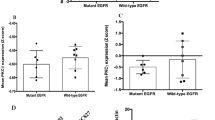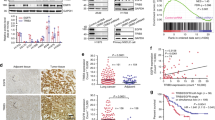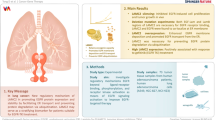Abstract
Non-small cell lung cancer (NSCLC) cells harboring activating mutations of the epidermal growth factor receptor (EGFR) tend to display elevated activity of several survival signaling pathways. Surprisingly, these mutations also correlate with reduced phosphorylation of ERK and SHP2, a protein tyrosine phosphatase required for complete ERK activation downstream of most receptor tyrosine kinases. As ERK activity influences cellular response to EGFR inhibition, altered SHP2 function could have a role in the striking response to gefitinib witnessed with EGFR mutation. Here, we demonstrate that impaired SHP2 phosphorylation correlates with diminished SHP2 function in NSCLC cells expressing mutant, versus wild-type, EGFR. In NSCLC cells expressing wild-type EGFR, SHP2 knockdown decreased ERK phosphorylation, basally and in response to gefitinib, and increased cellular sensitivity to gefitinib. In cells expressing EGFR mutants, these effects of SHP2 knockdown were less substantial, but the expression of constitutively active SHP2 reduced cellular sensitivity to gefitinib. In cells expressing EGFR mutants, which do not undergo efficient ligand-mediated endocytosis, SHP2 was basally associated with GRB2-associated binder 1 (GAB1) and EGFR, and SHP2’s presence in membrane fractions was dependent on EGFR activity. Whereas EGF promoted a more uniform intracellular distribution of initially centrally localized SHP2 in cells expressing wild-type EGFR, SHP2 was basally evenly distributed and did not redistribute in response to EGF in cells with EGFR mutation. Thus, EGFR mutation may promote association of a fraction of SHP2 at the plasma membrane with adapters that promote SHP2 activity. Consistent with this, SHP2 immunoprecipitated from cells with EGFR mutation was active, and EGF treatment did not change this activity. Overall, our data suggest that a fraction of SHP2 is sequestered at the plasma membrane in cells with EGFR mutation in a way that impedes SHP2’s ability to promote ERK activity and identify SHP2 as a potential target for co-inhibition with EGFR in NSCLC.
This is a preview of subscription content, access via your institution
Access options
Subscribe to this journal
Receive 50 print issues and online access
$259.00 per year
only $5.18 per issue
Buy this article
- Purchase on Springer Link
- Instant access to full article PDF
Prices may be subject to local taxes which are calculated during checkout









Similar content being viewed by others
References
Lynch TJ, Bell DW, Sordella R, Gurubhagavatula S, Okimoto RA, Brannigan BW et al. Activating mutations in the epidermal growth factor receptor underlying responsiveness of non-small-cell lung cancer to gefitinib. N Engl J Med 2004; 350: 2129–2139.
Sordella R, Bell DW, Haber DA, Settleman J . Gefitinib-sensitizing EGFR mutations in lung cancer activate anti-apoptotic pathways. Science 2004; 305: 1163–1167.
Fukuoka M, Yano S, Giaccone G, Tamura T, Nakagawa K, Douillard JY et al. Multi-institutional randomized phase II trial of gefitinib for previously treated patients with advanced non-small-cell lung cancer (The IDEAL 1 Trial) [corrected]. J Clin Oncol 2003; 21: 2237–2246.
Akca H, Tani M, Hishida T, Matsumoto S, Yokota J . Activation of the AKT and STAT3 pathways and prolonged survival by a mutant EGFR in human lung cancer cells. Lung Cancer 2006; 54: 25–33.
Engelman JA, Janne PA, Mermel C, Pearlberg J, Mukohara T, Fleet C et al. ErbB-3 mediates phosphoinositide 3-kinase activity in gefitinib-sensitive non-small cell lung cancer cell lines. Proc Natl Acad Sci USA 2005; 102: 3788–3793.
Guo A, Villen J, Kornhauser J, Lee KA, Stokes MP, Rikova K et al. Signaling networks assembled by oncogenic EGFR and c-Met. Proc Natl Acad Sci USA 2008; 105: 692–697.
Lazzara MJ, Lane K, Chan R, Jasper PJ, Yaffe MB, Sorger PK et al. Impaired SHP2-mediated extracellular signal-regulated kinase activation contributes to gefitinib sensitivity of lung cancer cells with epidermal growth factor receptor-activating mutations. Cancer Res 2010; 70: 3843–3850.
Neel BG, Gu H, Pao L . The ‘Shp’ing news: SH2 domain-containing tyrosine phosphatases in cell signaling. Trends Biochem Sci 2003; 28: 284–293.
Araki T, Nawa H, Neel BG . Tyrosyl phosphorylation of Shp2 is required for normal ERK activation in response to some, but not all, growth factors. J Biol Chem 2003; 278: 41677–41684.
Gu H, Neel BG . The "Gab" in signal transduction. Trends Cell Biol 2003; 13: 122–130.
Hynes NE, Lane HA . ERBB receptors and cancer: the complexity of targeted inhibitors. Nat Rev Cancer 2005; 5: 341–354.
Shi ZQ, Yu DH, Park M, Marshall M, Feng GS . Molecular mechanism for the Shp-2 tyrosine phosphatase function in promoting growth factor stimulation of Erk activity. Mol Cell Biol 2000; 20: 1526–1536.
Chan G, Kalaitzidis D, Neel BG . The tyrosine phosphatase Shp2 (PTPN11) in cancer. Cancer Metastasis Rev 2008; 27: 179–192.
Kontaridis MI, Swanson KD, David FS, Barford D, Neel BG . PTPN11 (Shp2) mutations in LEOPARD syndrome have dominant negative, not activating, effects. J Biol Chem 2006; 281: 6785–6792.
Bentires-Alj M, Paez JG, David FS, Keilhack H, Halmos B, Naoki K et al. Activating mutations of the noonan syndrome-associated SHP2/PTPN11 gene in human solid tumors and adult acute myelogenous leukemia. Cancer Res 2004; 64: 8816–8820.
Vieira AV, Lamaze C, Schmid SL . Control of EGF receptor signaling by clathrin-mediated endocytosis. Science 1996; 274: 2086–2089.
Hendriks BS, Griffiths GJ, Benson R, Kenyon D, Lazzara M, Swinton J et al. Decreased internalisation of erbB1 mutants in lung cancer is linked with a mechanism conferring sensitivity to gefitinib. Syst Biol (Stevenage) 2006; 153: 457–466.
Salvi M, Stringaro A, Brunati AM, Agostinelli E, Arancia G, Clari G et al. Tyrosine phosphatase activity in mitochondria: presence of Shp-2 phosphatase in mitochondria. Cell Mol Life Sci 2004; 61: 2393–2404.
Maroun CR, Naujokas MA, Holgado-Madruga M, Wong AJ, Park M . The tyrosine phosphatase SHP-2 is required for sustained activation of extracellular signal-regulated kinase and epithelial morphogenesis downstream from the met receptor tyrosine kinase. Mol Cell Biol 2000; 20: 8513–8525.
Turke AB, Zejnullahu K, Wu YL, Song Y, Dias-Santagata D, Lifshits E et al. Preexistence and clonal selection of MET amplification in EGFR mutant NSCLC. Cancer Cell 2010; 17: 77–88.
Yano S, Wang W, Li Q, Matsumoto K, Sakurama H, Nakamura T et al. Hepatocyte growth factor induces gefitinib resistance of lung adenocarcinoma with epidermal growth factor receptor-activating mutations. Cancer Res 2008; 68: 9479–9487.
Coldren CD, Helfrich BA, Witta SE, Sugita M, Lapadat R, Zeng C et al. Baseline gene expression predicts sensitivity to gefitinib in non-small cell lung cancer cell lines. Mol Cancer Res 2006; 4: 521–528.
Wang SE, Narasanna A, Perez-Torres M, Xiang B, Wu FY, Yang S et al. HER2 kinase domain mutation results in constitutive phosphorylation and activation of HER2 and EGFR and resistance to EGFR tyrosine kinase inhibitors. Cancer Cell 2006; 10: 25–38.
Offterdinger M, Bastiaens PI . Prolonged EGFR signaling by ERBB2-mediated sequestration at the plasma membrane. Traffic 2008; 9: 147–155.
Hendriks BS, Opresko LK, Wiley HS, Lauffenburger D . Coregulation of epidermal growth factor receptor/human epidermal growth factor receptor 2 (HER2) levels and locations: quantitative analysis of HER2 overexpression effects. Cancer Res 2003; 63: 1130–1137.
Zhou X, Agazie YM . Molecular mechanism for SHP2 in promoting HER2-induced signaling and transformation. J Biol Chem 2009; 284: 12226–12234.
Paulsen CE, Truong TH, Garcia FJ, Homann A, Gupta V, Leonard SE et al. Peroxide-dependent sulfenylation of the EGFR catalytic site enhances kinase activity. Nat Chem Biol 2011; 8: 57–64.
Ren Y, Chen Z, Chen L, Fang B, Win-Piazza H, Haura E et al. Critical role of Shp2 in tumor growth involving regulation of c-Myc. Genes Cancer 2010; 1: 994–1007.
Sharma SV, Bell DW, Settleman J, Haber DA . Epidermal growth factor receptor mutations in lung cancer. Nat Rev Cancer 2007; 7: 169–181.
Ventura A, Meissner A, Dillon CP, McManus M, Sharp PA, Van Parijs L et al. Cre-lox-regulated conditional RNA interference from transgenes. Proc Natl Acad Sci USA 2004; 101: 10380–10385.
Wickrema A, Uddin S, Sharma A, Chen F, Alsayed Y, Ahmad S et al. Engagement of Gab1 and Gab2 in erythropoietin signaling. J Biol Chem 1999; 274: 24469–24474.
Acknowledgements
CMF was supported in part by the University of Pennsylvania Cell and Molecular Biology Training Grant (T32 GM-07229), grant R25 CA101871-07 from the National Cancer Institute and a fellowship from the Ashton Foundation. AMR received support from the University of Pennsylvania Institute for Regenerative Medicine. This project was funded, in part, under a grant with the Pennsylvania Department of Health. The Department specifically disclaims responsibility for any analyses, interpretations or conclusions. Support for DN was provided by the National Institutes of Health Grant 1R01DK087956 through the NIDDK. This work was also supported in part by laboratory startup funds from the University of Pennsylvania. We thank Dr Ben Neel, Dr Eric Haura, Dr Pasi Jänne, Dr Tyler Jacks, Dr Marilyn Farquhar, Dr Gary Nolan, Dr Anil Rustgi and Dr Susan Margulies for generously providing reagents and access to instrumentation. We also thank Ms Gladys Gray Lawrence, Dr Ranganath Parthasarathy, Mr Calixte Monast and Ms Alice Macdonald Walsh for technical assistance.
Author information
Authors and Affiliations
Corresponding author
Ethics declarations
Competing interests
The authors declare no conflict of interest.
Additional information
Supplementary Information accompanies the paper on the Oncogene website
Supplementary information
Rights and permissions
About this article
Cite this article
Furcht, C., Muñoz Rojas, A., Nihalani, D. et al. Diminished functional role and altered localization of SHP2 in non-small cell lung cancer cells with EGFR-activating mutations. Oncogene 32, 2346–2355 (2013). https://doi.org/10.1038/onc.2012.240
Received:
Revised:
Accepted:
Published:
Issue Date:
DOI: https://doi.org/10.1038/onc.2012.240



